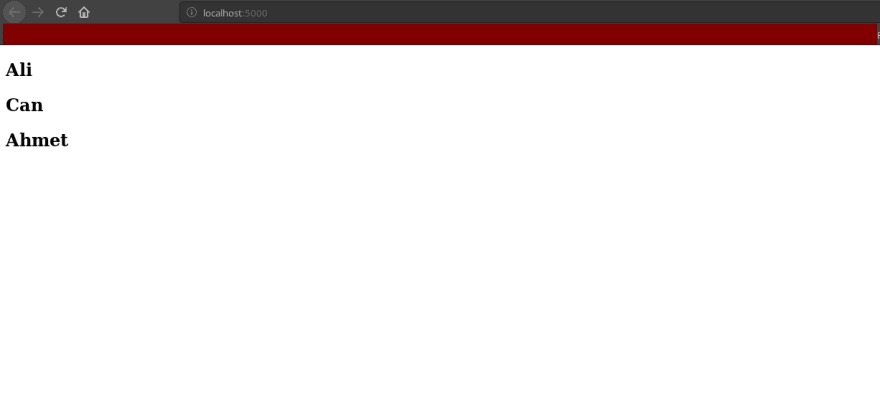Developing an Express Application Using TypeScript

Itachi Uchiha
Posted on November 3, 2019

This post was first published on my blog.
Recently, I was working on TypeScript. I asked a question about TypeScript. Dev users helped me.
In this post, I'll show you how to create an express application using TypeScript.
Before you start, I'm so sorry for my grammar mistakes.
Express Framework
As you know, Express is a NodeJS web framework that works on the server.
Installation of Dependencies
npm i express pug ts-node typescript @types/express @types/node
These are dependencies.
Edit package.json and tsconfig.json files
The scripts section in the package.json will be like that;
"scripts": {
"dev": "ts-node src/server.ts",
"start": "ts-node dist/server.js",
"build": "tsc -p ."
}
I'll be able to run the dev version of this application using the npm run dev command.
My tsconfig.json file will be like that;
{
"compilerOptions": {
"sourceMap": true,
"target": "es6",
"module": "commonjs",
"outDir": "./dist",
"baseUrl": "./src"
},
"include": [
"src/**/*.ts"
],
"exclude": [
"node_modules"
]
}
Project Structure
This is our project structure;
- dist
- node_modules
- public
- src
- views
package.json
tsconfig.json
By the way, public and views folders are not necessary if you don’t need UI in your project. (For example API backend). The project will develop under the src folder.
- controllers
- interfaces
- middleware
app.ts
server.ts
The controllers folder will have route controllers and their interface files. The interfaces folder will have interface files. The middleware folder will have our middlewares.
Let's look at the app.ts and server.ts files
Application File src/(app.ts)
My application file is like that;
import * as express from 'express'
import { Application } from 'express'
class App {
public app: Application
public port: number
constructor(appInit: { port: number; middleWares: any; controllers: any; }) {
this.app = express()
this.port = appInit.port
this.middlewares(appInit.middleWares)
this.routes(appInit.controllers)
this.assets()
this.template()
}
private middlewares(middleWares: { forEach: (arg0: (middleWare: any) => void) => void; }) {
middleWares.forEach(middleWare => {
this.app.use(middleWare)
})
}
private routes(controllers: { forEach: (arg0: (controller: any) => void) => void; }) {
controllers.forEach(controller => {
this.app.use('/', controller.router)
})
}
private assets() {
this.app.use(express.static('public'))
this.app.use(express.static('views'))
}
private template() {
this.app.set('view engine', 'pug')
}
public listen() {
this.app.listen(this.port, () => {
console.log(`App listening on the http://localhost:${this.port}`)
})
}
}
export default App
As you can see, the constructor expects three parameters. In this logic, port and controller parameters should be required but I wasn't sure about it. I've also init the assets and templates in case you use the UI in your project.
Server File src/(server.ts)
My server file is like that;
import App from './app'
import * as bodyParser from 'body-parser'
import loggerMiddleware from './middleware/logger'
import PostsController from './controllers/posts/posts.controller'
import HomeController from './controllers/home/home.controller'
const app = new App({
port: 5000,
controllers: [
new HomeController(),
new PostsController()
],
middleWares: [
bodyParser.json(),
bodyParser.urlencoded({ extended: true }),
loggerMiddleware
]
})
app.listen()
In this file, we've imported our App class. We passed three parameters. The first one port number. Our app will run on port 5000.
The second one is the controllers parameter. Our controller classes will be here with the new keyword.
And the last one middleWares. If you're using bodyParser or similar plugins you can use the middleWares.
Our Simple Middleware (middleware/logger.ts)
import { Request, Response } from 'express'
const loggerMiddleware = (req: Request, resp: Response, next) => {
console.log('Request logged:', req.method, req.path)
next()
}
export default loggerMiddleware
This is a simple HTTP logger. It shows the HTTP verb and its path.
IControlerBase (interfaces/IControllerBase.interface.ts)
I thought so that every controller has to implement this interface.
interface IControllerBase {
initRoutes(): any
}
export default IControllerBase
Our First Controller (controllers/home.controller.ts)
HomeController will be like that;
import * as express from 'express'
import { Request, Response } from 'express'
import IControllerBase from 'interfaces/IControllerBase.interface'
class HomeController implements IControllerBase {
public path = '/'
public router = express.Router()
constructor() {
this.initRoutes()
}
public initRoutes() {
this.router.get('/', this.index)
}
index = (req: Request, res: Response) => {
const users = [
{
id: 1,
name: 'Ali'
},
{
id: 2,
name: 'Can'
},
{
id: 3,
name: 'Ahmet'
}
]
res.render('home/index', { users })
}
}
export default HomeController
We've implemented the IControllerBase. So, we must follow its rules. In this example controller file, we're assuming that we have data from the database server. I sent this data to the (home/index.pug) file. This file is located under the views folder.
<!DOCTYPE html>
html(lang="en")
head
meta(charset="UTF-8")
meta(name="viewport", content="width=device-width, initial-scale=1.0")
meta(http-equiv="X-UA-Compatible", content="ie=edge")
title Document
body
each user, index in users
h2(onclick=`alert(${index})`)= user.name
This is our pug file. We've also implemented the initRoutes method. Because the boss(IControllerBase) wants that.
Let's start the app
npm run dev
With this command, we will be able to run our application. Our application works on http://localhost:5000.
You can also check the posts folder. In this project, you can use TypeORM or Sequelize.
You can find this project on GitHub: https://github.com/aligoren/express-typescript-test
Conclusion
I really loved to use TypeScript. Before this work, I never had an idea about how TypeScript works.
Thanks for reading.

Posted on November 3, 2019
Join Our Newsletter. No Spam, Only the good stuff.
Sign up to receive the latest update from our blog.
Related
September 24, 2024


